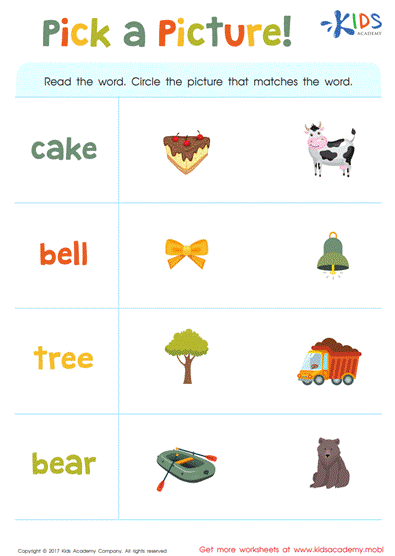-
English
-
English Pre-K
-
Unit 1: Early Literacy Skills
-
ABCs
- Pre-writing Activities
- Letter A
- Letter B
- Letter C
- Letter D
- Letter E
- Letter F
- Letter G
- Letter H
- Letter I
- Letter J
- Letter K
- Letter L
- Letter M
- Letter N
- Letter O
- Letter P
- Letter Q
- Letter R
- Letter S
- Letter T
- Letter U
- Letter V
- Letter W
- Letter X
- Letter Y
- Letter Z
-
Phonological Awareness
- Rhyming Words
- Letter Sounds B, C, D, and F
- Letter Sounds G, H, J, and K
- Letter Sounds L, M, N, and P
- Letter Sounds Q, R, S, and T
- Letter Sounds V, W, X, Y, and Z
- Letter Sounds A, E, and I
- Letter Sounds O and U
- Beginning Sounds
- Matching Letters to Sounds
-
ABCs
-
Unit 2: Vocabulary
-
Common Words
- Sorting Words into Categories
- Color Words
- Verbs and Adjectives
-
Sight Words
- Sight Words 'I' and 'Can'
- Sight Words 'You' and 'Like'
-
Common Words
-
Unit 3: Print Awareness
-
Parts of a Book
- Working with a Book
- Spaces Between Words
- Text and Illustrations
-
Picture Books and Poems
- Picture Book Text Features
- Poem Text Features
- Signs and Labels in the Community
-
Parts of a Book
-
Unit 4: Reading Literature
- Questions About Stories
- Discussing Stories
-
Unit 5: Reading Informational Texts
- Retelling Details in a Text
- Questions About a Text
- Connections Between Events
- Text Features
- Describing Illustrations
-
Unit 1: Early Literacy Skills
-
English Pre-K
-
Math
-
Math for Pre-Kindergarten
-
Logic and Geometry
-
Matching and Sorting
- Same and Different
- Which One Is a Little Different?
- Objects That Go Together
- Sorting by Color and Size
- Sorting The Same Group in Different Ways
- Patterns
-
Shapes
- Shapes in Our Environment
- Naming Shapes Regardless of Size
- Making Shapes in Preschool
- Comparing Shapes
- Relative Positions
- Sorting Shapes
-
Matching and Sorting
-
Early Number Sense
-
Numbers 1–5
- Counting to 3
- Counting to 5
- Arranging Objects up to 3 Objects
- Arranging up to 5 Objects
- Writing Numbers 1–5
-
Numbers 1–5
-
Numbers up to 10
- Counting to 10
- Arranging up to 10 Objects
- Number 0
- Writing Numbers 6–10
- Breaking Down Numbers 6-10
-
Logic and Geometry
-
Math for Pre-Kindergarten
Matching Letters to Sounds
Up until now, your child has only been learning how to identify and manipulate sounds. In this lesson, we are introducing a new skill called “letter-sound correspondence” that relates not only to the sounds in words, but also to the letters that represent them. Letter-sound correspondence is the ability to recognize both the letters that represent sounds, and the sounds that represent letters.
Learning this skill is essential for your child’s language learning journey for two main reasons:
(1) For them to learn how to read, they will need to know which sound each letter makes, and
(2) for them to learn how to spell and write, they will need the knowledge of which letter represents each sound they are pronouncing.
The process of teaching your child the letters and their corresponding sounds is best done one letter at a time. There hasn’t been any strict established order by which they are taught, but it is considered efficient to teach them based on frequency of use and ease of production. Thus, as suggested by the Literacy Instruction website, a good order to teach letter-sound correspondence is the following: a, m, t, p, o, n, c, d, u, s, g, h, i, f, b, l, e, r, w, k, x, v, y, z, j, q.
Activities
Activities are a great way to help your child practice the knowledge they acquire. One tool you might find handy while teaching letter-sound correspondence is alphabet flashcards. They can be used in several activities at home. The simplest way to utilize these flashcards is by either showing your child the card and having them say its corresponding sound, or you say a sound and they have to produce the letter that represents it. Another fun activity you can perform using flashcards is a miniature scavenger hunt. Fill a sensory bin with sand, and hide small items from around the house in it. Have your child find the items, name them, and place each on the letter it starts with on its corresponding flashcard.
Another useful companion to teaching letter-sound correspondence is worksheets. You can find various educational worksheets on our Kids Academy website to offer your child as revision at the end of the lesson. Start with this easy colorful “What Sound is it?” worksheet, where your kid will name the image, and then identify the missing sound and circle the letter corresponding to it.
The below “Word Matching Game” worksheet is a bit more challenging as it tests the child’s reading abilities using words that look and sound quite similar. For example, one of the exercises is the image of a bee, and the child is supposed to match it to one of three words: 'bee', 'ball' and 'tree'.
Finally, this “Pick a Picture” worksheet is the opposite of the previous one. Your child will work on their word recognition skills through reading a word, then circling the correct image.
By the end of this lesson, your emerging reader will be able not only to recognize letters and their corresponding sounds, but also to blend sounds together and segment them in order to make and recognize words. These skills are the stepping stones towards their future reading and writing.




